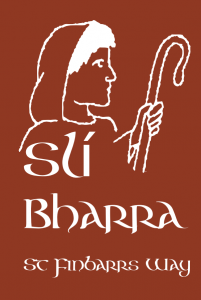St. Finbarr’s Pilgrim Way leads from Carriganass Castle to Gougane Barra where you will find the site of the hermitage, founded by St. Finbarr towards the end of the sixth century, and the famous church on the lake.
The route, which forms part of the longer ‘St. Finbarr’s Way marks the point at which the stories of St. Finbarr and Donal Cam O’Sullivan Beare intersect.
Though St Finbarr lived about a thousand years before Donal Cam O’Sullivan Beare – the last owner of Carriganass Castle – the castle and the saint’s shrine, have strong cultural links.
The hermitage is a remote place for spiritual reflection, and became a renowned place of pilgrimage as Ireland went through political turmoil and disruption. Donal Cam O’Sullivan, and his followers, would have marched by it on their retreat march in January 1603.
It is very likely that the group would have paused at the shrine there to invoke the protection of St. Finbarr against the hazards of the long tragic journey they planned to make to Leitrim where Donal Cam joined the Flight of the Earls.
The Route of St. Finbarr’s Pilgrim’s Way
From the castle entrance, follow the road to the left, past the picnic area. After 0.5km, you will cross a bridge over the Owenbeg river.
At the junction after the bridge, take the right turn, and follow the narrow road which gradually ascends into the foothills. Banty Bay will come into view as the road rises.
After about 2.5km, leave the roadway, using a stile on the left-hand side of the road. Follow the markers along the plantation track which ascends sharply towards the crest of the hill at Knockbreteen.
At the crest of the hill, follow the way markers west along the fence. Be careful here on the rough terrain.
Watch out for a small stile near a forest plantation, and cross to the other side of the fence here.
Enjoy the panoramic views over three valleys, with Cnoc Baoi (the highest peak in West Cork) to the north, the Sugar Loaf and Hungry Hill to the west and Mullaghmesha to the south.
Follow the markers west until you reach a dip in the ridge. Make a sharp turn right to the north, and descend the steep firebreak over boggy wet ground to a stile which brings you out onto the Maugha road, and Beara-Breifne Way.
Cnon an Áir (the hill of slaughter) can be seen across the valley, and there are views across the blanket bogland of Maugha.
At the roadway, turn right and follow the Gougane Barra sign for 1.9km to the end of the Maugha road. Go through the gateway here, and follow the markers in the timber yard on towards a rough track.
Follow this attractive woodland track, which is on flat open terrain for 1km. At the end of the track, makers will lead you through forestry land for 450 metres, and on to the Lackavane road.
Watch out for wet boggy patches and forest drainage.
At Lackavane road, turn left, following the sign for Gougane Barra for 1.3km, along a road which leads upward to a hillside farmhouse.
From here, you’ll see a wind farm and the Owenbeg river. The bridge marks the halfway mark of your walk, and it makes a good spot to stop for a break on your walk.
Follow the way markers which lead from the road onto a lane-way to the left of the farmhouse.
Cross the open field to reach the hard track which rises sharply behind the farmhouse. This stretch of the walk involves a strenuous climb to the end of the track.
When you reach the track’s end, follow the markers on the open hillside to the crest of the hill and a fence which rises gradually towards the Gougane Barra horseshoe.
The Owenbeg river below is falling from its source, Loch na mBan which comes into view as you approach the top of the hill.
When you arrive at the top of the hill, between two lakes, cross the stile and follow the fence to the right.
Weather permitting, you’ll have spectacular views of Cúm Rua cliffs, St. Finbarr’s Shrine and the lake at Gougane Barra.
Follow the markers by the fence, over rough terrain, until you reach another fence which goes sharply left. Descend with great care over slippery wet ground on Faill A’Stuaicín (the south side of the horseshoe).
Markers lead down to a stile at the corner of a wood.
Cross the stile, and follow the rough track which gradually winds down to the floor of the valley, and emerges on the road west of the shrine at the unusual, award-winning thatched toilet block.
Turn right to head towards the shrine. This road leads out to the main road from Kealkill to Macroom.



